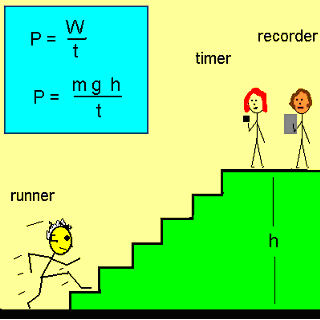Power!
In physics, power (symbol: P) is defined as the amount of energy consumed per unit time. In the MKS system, the unit of power is the joule per second (J/s), known as the watt (in honour of James Watt, the eighteenth-century developer of the steam engine). For example, the rate at which a light bulb converts electrical energy into heat and light is measured in watts—the more wattage, the more power, or equivalently the more electrical energy is used per unit time.

Energy transfer can be used to do work, so power is also the rate at which this work is performed. The same amount of work is done when carrying a load up a flight of stairs whether the person carrying it walks or runs, but more power is expended during the running because the work is done in a shorter amount of time. The output power of an electric motor is the product of the torque the motor generates and the angular velocity of its output shaft. The power expended to move a vehicle is the product of the traction force of the wheels and the velocity of the vehicle.
The dimension of power is energy divided by time. The SI unit of power is the watt (W), which is equal to one joule per second.
Blog entry of Saif Rehman
Could we perhaps include the ideas of P=I [Squared] R and P = V [Sq] / R somewhere into this post?
ReplyDeleteIt's a nice post about power. I really like it. It's really helpful. Thanks for sharing it.
ReplyDelete